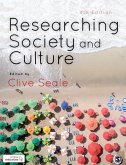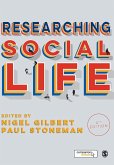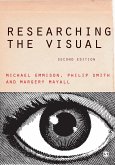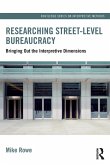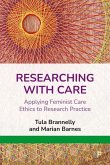Researching Society and Culture
Herausgeber: Rivas, Carol; Seale, Clive
Researching Society and Culture
Herausgeber: Rivas, Carol; Seale, Clive
- Broschiertes Buch
- Merkliste
- Auf die Merkliste
- Bewerten Bewerten
- Teilen
- Produkt teilen
- Produkterinnerung
- Produkterinnerung
With contributions from experts across disciplines, this edited collection gives beginner researchers a sound understanding of the theory and practice of conducting social research.
Andere Kunden interessierten sich auch für
![Researching Society and Culture Researching Society and Culture]() Researching Society and Culture142,99 €
Researching Society and Culture142,99 €![Researching Social Life Researching Social Life]() Researching Social Life141,99 €
Researching Social Life141,99 €![Researching the Visual Researching the Visual]() Michael EmmisonResearching the Visual72,99 €
Michael EmmisonResearching the Visual72,99 €![Researching Street-level Bureaucracy Researching Street-level Bureaucracy]() Mike Rowe (UK University of Liverpool)Researching Street-level Bureaucracy55,99 €
Mike Rowe (UK University of Liverpool)Researching Street-level Bureaucracy55,99 €![Researching Justice Researching Justice]() Researching Justice133,99 €
Researching Justice133,99 €![Researching Voluntary Action Researching Voluntary Action]() Researching Voluntary Action45,99 €
Researching Voluntary Action45,99 €![Researching with Care Researching with Care]() Tula Brannelly (Auckland University of Technology)Researching with Care37,99 €
Tula Brannelly (Auckland University of Technology)Researching with Care37,99 €-
-
-
With contributions from experts across disciplines, this edited collection gives beginner researchers a sound understanding of the theory and practice of conducting social research.
Hinweis: Dieser Artikel kann nur an eine deutsche Lieferadresse ausgeliefert werden.
Hinweis: Dieser Artikel kann nur an eine deutsche Lieferadresse ausgeliefert werden.
Produktdetails
- Produktdetails
- Verlag: Sage Publications Ltd
- 5 Revised edition
- Seitenzahl: 600
- Erscheinungstermin: 5. März 2025
- Englisch
- Abmessung: 191mm x 247mm x 41mm
- Gewicht: 1136g
- ISBN-13: 9781529628982
- ISBN-10: 1529628989
- Artikelnr.: 71662787
- Herstellerkennzeichnung
- Libri GmbH
- Europaallee 1
- 36244 Bad Hersfeld
- gpsr@libri.de
- Verlag: Sage Publications Ltd
- 5 Revised edition
- Seitenzahl: 600
- Erscheinungstermin: 5. März 2025
- Englisch
- Abmessung: 191mm x 247mm x 41mm
- Gewicht: 1136g
- ISBN-13: 9781529628982
- ISBN-10: 1529628989
- Artikelnr.: 71662787
- Herstellerkennzeichnung
- Libri GmbH
- Europaallee 1
- 36244 Bad Hersfeld
- gpsr@libri.de
Clive Seale has been Professor of Sociology (or Medical Sociology) at Goldsmiths and Queen Mary's (both University of London) and Brunel University. His work has concerned communication in health care and death in modern society. He has published extensively on research methods. His books include Constructing Death: the sociology of dying and bereavement (Cambridge University Press, 1998), The Quality of Qualitative Research (Sage, 1999), Media and Health (Sage, 2003) and Gender and the Language of Illness (Palgrave-Macmillan, 2010, with Jonathan Charteris-Black). Recently, he has turned to fiction, publishing a novel, Interrogating Ellie (Cloiff Books, 2015) using the pen name Julian Gray. He is currently writing another novel. Carol Rivas is an associate professor in Social Policy and Programme Evaluation in the Social Research Institute at University College London. For more than 30 years she has undertaken research on chronic health conditions and disabilities, abuse, and vulnerable populations. This has encompassed a range of conditions (e.g. multiple sclerosis, hypermobile Ehlers-Danlos syndromes, diabetes, partner abuse, depression, developmental disorders, cancer), and a variety of methods, from Big Data analyses through conversation analysis to small qualitative explorations. She is particularly interested in the intersection of health with race, ethnicity and migrant status. She currently leads on major research on the intersections of ethnicity, disability or chronic conditions, and the pandemic, including considerations of Long Covid and of vaccine uptake. Her research aims to develop practical and theoretical understandings of vulnerability and social interaction to use with linked research outputs to support instrumental changes in policy and practice. She has won several awards, particularly for her participatory methods. Carol also teaches courses on methods and on the use of evidence in policy and practice at both the undergraduate and postgraduate levels. She has edited a special issue on disability for the journal Evidence and Policy and has written a number of textbook chapters, for example for Researching Society and Culture, the Sage Handbook of Interview Research (2012 ed), and Selective Serotonin Reuptake Inhibitors Past, Present and Future, as well as publications in academic journals. She sits on a UK National Institutes of Health Research Commissioned and Researcher Led Funding panel. She holds a doctorate in medical sociology from Queen Mary University of London, a master's in Cognitive Neuropsychology from Birkbeck University London, and a bachelor's degree in zoology (brain and behaviour) from Queen Mary University of London.
Chapter 1: Introduction and guide to using this book - Clive Seale
Part 1: Starting out
Chapter 2: Philosophy, politics and values - Clive Seale
Chapter 3: Research and theory - Clive Seale
Chapter 4: Ethics and social research - Suki Ali and Moira Kelly
Chapter 5: Participatory research - Clive Seale
Chapter 6: Doing a literature review - Clive Seale
Chapter 7: Research questions and proposals - Moira Kelly
Chapter 8: Research design - Clive Seale
Part 2: Generating data
Chapter 9: Sampling - Clive Seale
Chapter 10: Questionnaires and interviews - Clive Seale
Chapter 11: Designing questions - Clive Seale
Chapter 12: Qualitative interviewing - Bridget Byrne
Chapter 13: Focus groups - Clive Seale
Chapter 14: Doing ethnography - Clive Seale
Chapter 15: Grounded theory - Clive Seale
Chapter 16: Documents and archives - Clive Seale
Chapter 17: Mixed methods - Natasha Howard and Neil Spicer
Chapter 18: Online data - Clive Seale
Part 3: Doing analysis
Chapter 19: Preparing data for statistical analysis - Clive Seale
Chapter 20: Analysing single variables - Clive Seale
Chapter 21: Bivariate analysis - Clive Seale
Chapter 22: Causal arguments and multivariate analysis - Clive Seale
Chapter 23: Secondary analysis - Clive Seale
Chapter 24: Content and text analysis - Clive Seale
Chapter 25: Thematic analysis - Carol Rivas
Chapter 26: Visual analysis - Suki Ali and Niamh Hayes
Chapter 27: Analysing discourse and narratives - Clive Seale
Chapter 28: Analysing conversation - Tim Rapley
Part 4: Writing, presenting, reflecting
Chapter 29: Writing a research report - Carol Rivas
Chapter 30: Oral presentations - Clive Seale
Chapter 31: Research quality - Clive Seale
Part 1: Starting out
Chapter 2: Philosophy, politics and values - Clive Seale
Chapter 3: Research and theory - Clive Seale
Chapter 4: Ethics and social research - Suki Ali and Moira Kelly
Chapter 5: Participatory research - Clive Seale
Chapter 6: Doing a literature review - Clive Seale
Chapter 7: Research questions and proposals - Moira Kelly
Chapter 8: Research design - Clive Seale
Part 2: Generating data
Chapter 9: Sampling - Clive Seale
Chapter 10: Questionnaires and interviews - Clive Seale
Chapter 11: Designing questions - Clive Seale
Chapter 12: Qualitative interviewing - Bridget Byrne
Chapter 13: Focus groups - Clive Seale
Chapter 14: Doing ethnography - Clive Seale
Chapter 15: Grounded theory - Clive Seale
Chapter 16: Documents and archives - Clive Seale
Chapter 17: Mixed methods - Natasha Howard and Neil Spicer
Chapter 18: Online data - Clive Seale
Part 3: Doing analysis
Chapter 19: Preparing data for statistical analysis - Clive Seale
Chapter 20: Analysing single variables - Clive Seale
Chapter 21: Bivariate analysis - Clive Seale
Chapter 22: Causal arguments and multivariate analysis - Clive Seale
Chapter 23: Secondary analysis - Clive Seale
Chapter 24: Content and text analysis - Clive Seale
Chapter 25: Thematic analysis - Carol Rivas
Chapter 26: Visual analysis - Suki Ali and Niamh Hayes
Chapter 27: Analysing discourse and narratives - Clive Seale
Chapter 28: Analysing conversation - Tim Rapley
Part 4: Writing, presenting, reflecting
Chapter 29: Writing a research report - Carol Rivas
Chapter 30: Oral presentations - Clive Seale
Chapter 31: Research quality - Clive Seale
Chapter 1: Introduction and guide to using this book - Clive Seale
Part 1: Starting out
Chapter 2: Philosophy, politics and values - Clive Seale
Chapter 3: Research and theory - Clive Seale
Chapter 4: Ethics and social research - Suki Ali and Moira Kelly
Chapter 5: Participatory research - Clive Seale
Chapter 6: Doing a literature review - Clive Seale
Chapter 7: Research questions and proposals - Moira Kelly
Chapter 8: Research design - Clive Seale
Part 2: Generating data
Chapter 9: Sampling - Clive Seale
Chapter 10: Questionnaires and interviews - Clive Seale
Chapter 11: Designing questions - Clive Seale
Chapter 12: Qualitative interviewing - Bridget Byrne
Chapter 13: Focus groups - Clive Seale
Chapter 14: Doing ethnography - Clive Seale
Chapter 15: Grounded theory - Clive Seale
Chapter 16: Documents and archives - Clive Seale
Chapter 17: Mixed methods - Natasha Howard and Neil Spicer
Chapter 18: Online data - Clive Seale
Part 3: Doing analysis
Chapter 19: Preparing data for statistical analysis - Clive Seale
Chapter 20: Analysing single variables - Clive Seale
Chapter 21: Bivariate analysis - Clive Seale
Chapter 22: Causal arguments and multivariate analysis - Clive Seale
Chapter 23: Secondary analysis - Clive Seale
Chapter 24: Content and text analysis - Clive Seale
Chapter 25: Thematic analysis - Carol Rivas
Chapter 26: Visual analysis - Suki Ali and Niamh Hayes
Chapter 27: Analysing discourse and narratives - Clive Seale
Chapter 28: Analysing conversation - Tim Rapley
Part 4: Writing, presenting, reflecting
Chapter 29: Writing a research report - Carol Rivas
Chapter 30: Oral presentations - Clive Seale
Chapter 31: Research quality - Clive Seale
Part 1: Starting out
Chapter 2: Philosophy, politics and values - Clive Seale
Chapter 3: Research and theory - Clive Seale
Chapter 4: Ethics and social research - Suki Ali and Moira Kelly
Chapter 5: Participatory research - Clive Seale
Chapter 6: Doing a literature review - Clive Seale
Chapter 7: Research questions and proposals - Moira Kelly
Chapter 8: Research design - Clive Seale
Part 2: Generating data
Chapter 9: Sampling - Clive Seale
Chapter 10: Questionnaires and interviews - Clive Seale
Chapter 11: Designing questions - Clive Seale
Chapter 12: Qualitative interviewing - Bridget Byrne
Chapter 13: Focus groups - Clive Seale
Chapter 14: Doing ethnography - Clive Seale
Chapter 15: Grounded theory - Clive Seale
Chapter 16: Documents and archives - Clive Seale
Chapter 17: Mixed methods - Natasha Howard and Neil Spicer
Chapter 18: Online data - Clive Seale
Part 3: Doing analysis
Chapter 19: Preparing data for statistical analysis - Clive Seale
Chapter 20: Analysing single variables - Clive Seale
Chapter 21: Bivariate analysis - Clive Seale
Chapter 22: Causal arguments and multivariate analysis - Clive Seale
Chapter 23: Secondary analysis - Clive Seale
Chapter 24: Content and text analysis - Clive Seale
Chapter 25: Thematic analysis - Carol Rivas
Chapter 26: Visual analysis - Suki Ali and Niamh Hayes
Chapter 27: Analysing discourse and narratives - Clive Seale
Chapter 28: Analysing conversation - Tim Rapley
Part 4: Writing, presenting, reflecting
Chapter 29: Writing a research report - Carol Rivas
Chapter 30: Oral presentations - Clive Seale
Chapter 31: Research quality - Clive Seale


